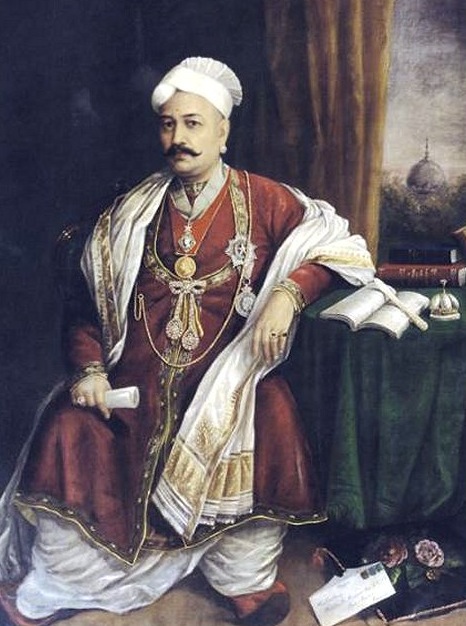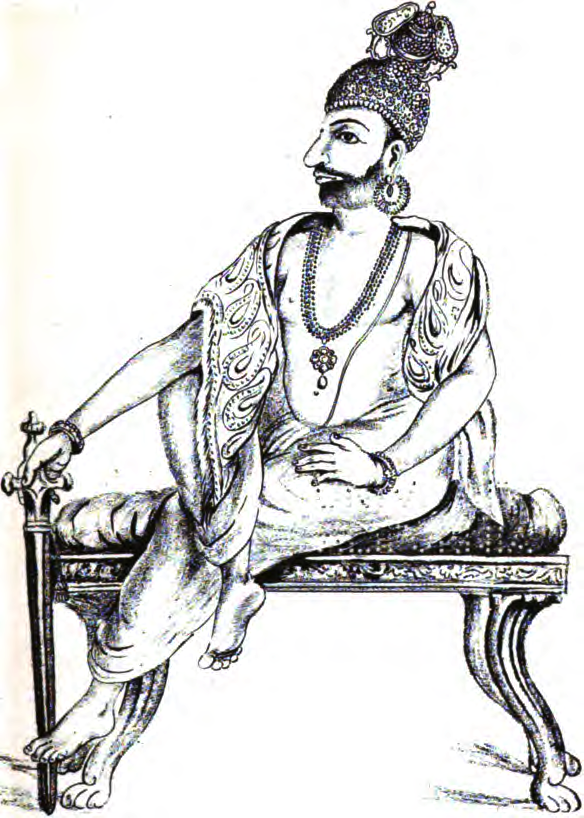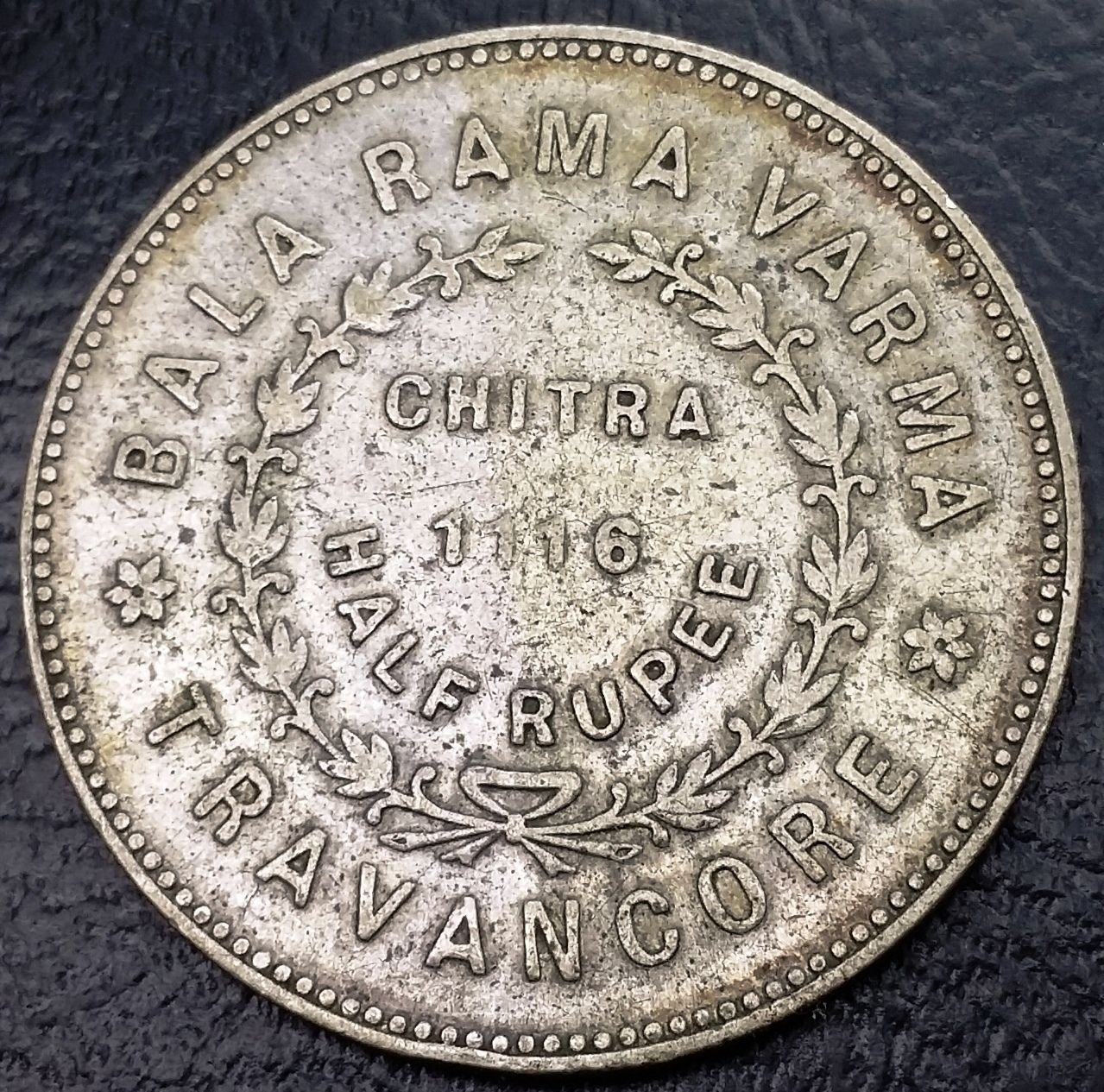|
Travancore State
The kingdom of Travancore (), also known as the kingdom of Thiruvithamkoor () or later as Travancore State, was a kingdom that lasted from until 1949. It was ruled by the Travancore Royal Family from Padmanabhapuram, and later Thiruvananthapuram. At its zenith, the kingdom covered most of the south of modern-day Kerala (Idukki, Kottayam, Alappuzha, Pathanamthitta, Kollam, and Thiruvananthapuram districts, major portions of Ernakulam district, Puthenchira village of Thrissur district) and the southernmost part of modern-day Tamil Nadu ( Kanyakumari district and some parts of Tenkasi district) with the Thachudaya Kaimal's enclave of Irinjalakuda Koodalmanikyam temple in the neighbouring kingdom of Cochin. However Tangasseri area of Kollam city and Anchuthengu near Attingal in Thiruvananthapuram were parts of British India. Malabar District of Madras Presidency was to the north, the Madurai and Tirunelveli districts of Pandya Nadu region in Madras Presidency to the east, ... [...More Info...] [...Related Items...] OR: [Wikipedia] [Google] [Baidu] |
Age Of Imperialism
Imperialism is the maintaining and extending of power over foreign nations, particularly through expansionism, employing both hard power (military and economic power) and soft power ( diplomatic power and cultural imperialism). Imperialism focuses on establishing or maintaining hegemony and a more formal empire. While related to the concept of colonialism, imperialism is a distinct concept that can apply to other forms of expansion and many forms of government. Etymology and usage The word ''imperialism'' was derived from the Latin word , which means 'to command', 'to be sovereign', or simply 'to rule'. It was coined in the 19th century to decry Napoleon III's despotic militarism and his attempts at obtaining political support through foreign military interventions. The term became common in the current sense in Great Britain during the 1870s; by the 1880s it was used with a positive connotation. By the end of the 19th century, the term was used to describe the behavior of e ... [...More Info...] [...Related Items...] OR: [Wikipedia] [Google] [Baidu] |
Islam
Islam is an Abrahamic religions, Abrahamic monotheistic religion based on the Quran, and the teachings of Muhammad. Adherents of Islam are called Muslims, who are estimated to number Islam by country, 2 billion worldwide and are the world's Major religious groups, second-largest religious population after Christians. Muslims believe that Islam is the complete and universal version of a Fitra, primordial faith that was revealed many times through earlier Prophets and messengers in Islam, prophets and messengers, including Adam in Islam, Adam, Noah in Islam, Noah, Abraham in Islam, Abraham, Moses in Islam, Moses, and Jesus in Islam, Jesus. Muslims consider the Quran to be the verbatim word of God in Islam, God and the unaltered, final revelation. Alongside the Quran, Muslims also believe in previous Islamic holy books, revelations, such as the Torah in Islam, Tawrat (the Torah), the Zabur (Psalms), and the Gospel in Islam, Injil (Gospel). They believe that Muhammad in Islam ... [...More Info...] [...Related Items...] OR: [Wikipedia] [Google] [Baidu] |
Travancore Royal Family
The Travancore royal family was the ruling house of the Kingdom of Travancore. They signed a treaty with the British in 1788, thereby adopting British dominance. Later, in 1805, they revised the treaty, leading to a diminution of royal authority and the loss of political independence for Travancore. They had to give up their ruling rights over the common people in 1949 when Travancore were forced to merge with Independent India and their political pension Privy Purse in India, privileges were abolished in 1971. The royal family was alternatively known as the Kupaka Swaroopam, Thripappur Swaroopam, Venad Swaroopam, Vanchi Swaroopam etc. It has its seat today at Thiruvananthapuram in Kerala, India. In the 18th century CE, the Travancore royal family adopted some members from the royal family of Kolathunadu based at Kannur, and Parappanad based in present-day Malappuram district. History and legends of the dynasty The family descends from ancient Kings. The first recorded ins ... [...More Info...] [...Related Items...] OR: [Wikipedia] [Google] [Baidu] |
India
India, officially the Republic of India, is a country in South Asia. It is the List of countries and dependencies by area, seventh-largest country by area; the List of countries by population (United Nations), most populous country since 2023; and, since its independence in 1947, the world's most populous democracy. Bounded by the Indian Ocean on the south, the Arabian Sea on the southwest, and the Bay of Bengal on the southeast, it shares land borders with Pakistan to the west; China, Nepal, and Bhutan to the north; and Bangladesh and Myanmar to the east. In the Indian Ocean, India is near Sri Lanka and the Maldives; its Andaman and Nicobar Islands share a maritime border with Thailand, Myanmar, and Indonesia. Modern humans arrived on the Indian subcontinent from Africa no later than 55,000 years ago., "Y-Chromosome and Mt-DNA data support the colonization of South Asia by modern humans originating in Africa. ... Coalescence dates for most non-European populations averag ... [...More Info...] [...Related Items...] OR: [Wikipedia] [Google] [Baidu] |
List Of Diwans Of Travancore
The Diwan or Dewan of Travancore was the head of government of Travancore in the nineteenth and twentieth centuries, serving at the pleasure of the Maharaja, corresponding to a prime minister, and consisting in the formal titles Valiya Sarvadhikaryakar and Dalavayi, Dalawa until the insurrection of Velu Thampi Dalawa and administrative reforms of John Munro, 9th of Teaninich, John Munro. Post-Munro, the title of ''Dalawa'', which remained formally the highest ranking established office, though administratively impotent, was revived as a sinecure to sideline Raman Menon and remove him from the Diwanship. The office of Diwan existed until 1948, when it gave way to the office of Prime Minister of Travancore. List of Diwans * Arumukan Pillai (1729–1736) * Nanu Pillai (1736–1737) * Ramayyan Dalawa (1737–1756) * Martandan bagavathi Pillai (1756–1763) * Subbayyan Dalawa (1763–1768) * Krishna Gopalayyan Iyyer (1768–1776) * Vadiswaran Subbrahmanya Iyer (1776–1780) * Mullen ... [...More Info...] [...Related Items...] OR: [Wikipedia] [Google] [Baidu] |
Maharaja Of Travancore
The Maharaja of Travancore was the principal title of the ruler of the Kingdom of Travancore in the southern part of Kerala, India. The Maharaja of Travancore was the topmost ruler of Travancore until 1949, when Travancore was acceded to India. Since then, the Maharaja of Travancore has remained in a titular position. Maharajas and Maharanis of the Kingdom of Travancore Maharanis of the Kingdom of Travancore (Aatingal Rani ) The rani of Attingal was the head of her principality and the eldest woman of the Trippapur svarupam. That meaning was specifically applied to the ranis of Attingal, in other parts of India this word had another definition. Because Travancore knew a marumakkathayam or matrilinear form of succession, the rani of Attingal had a special position. This meant that the eldest son of the rani was the first successor to Travancore's throne. His brothers and sisters were seated on the thrones of the other principalities. Therefore, the rani of Attingal could be ... [...More Info...] [...Related Items...] OR: [Wikipedia] [Google] [Baidu] |
Chithira Thirunal Balarama Varma
Sree Padmanabhadasa Sree Chithira Thirunal Balarama Varma , popularly known as Sree Chithira Thirunal (7 November 1912 – 20 July 1991), was the last ruling Maharaja of the Indian princely state of Travancore, in southern India until 1949 and later the Titular ruler, Titular Maharajah of Travancore until 1991. His reign is known for Chithira Thirunal Balarama Varma#Maharajah of Travancore, several notable reforms that have indelible impact on the society and culture of Kerala. Sree Chithira Thirunal was the eldest son of Junior Maharani of Travancore, Sethu Parvathi Bayi, and Sri Pooram Nal Ravi Varma Koyi Thampuran of the Royal House of Kilimanoor. He was privately educated, and became the Maharajah of Travancore, at the age of 11, upon the death of his maternal great uncle, the then Maharajah of Travancore Sree Moolam Thirunal, on 7 August 1924. For the duration of his reign he was either under a regency or effectively controlled by his autocratic Dewan, Sir C.P. Ramaswami Iy ... [...More Info...] [...Related Items...] OR: [Wikipedia] [Google] [Baidu] |
Swathi Thirunal Rama Varma
Sri Swathi Thirunal Rama Varma III (16 April 1813 – 26 December 1846) was the Maharaja of the Kingdom of Travancore. He was a great musician and composer who has to his credit over 400 classical compositions in both Carnatic and Hindustani style. A code of laws, courts of justice, introduction of English education, construction of an observatory, installation of the first Government printing press, establishment of the first manuscripts library were amongst the many initiatives taken by Swathi Thirunal, as a King, to modernize Travancore. Early life Swathi Thirunal was born into the Venad dynasty of the Matrilineal Travancore royal family, royal family of Travancore, which is now a part of Kerala, on 16 April 1813. He was the second child of Queen Gowri Lakshmi Bayi who ruled Travancore from 1810 to 1815, and Raja Raja Varma Koil Thampuran of Changanasseri Palace, and the elder son. While in the womb itself, he was proclaimed King and thus was referred to as Garbha Sreema ... [...More Info...] [...Related Items...] OR: [Wikipedia] [Google] [Baidu] |
Marthanda Varma
Anizham Thirunal Marthanda Varma (Malayalam: ; 1706 – 7 July 1758) was the founding monarch of the southern Indian Kingdom of Travancore (previously Venadu) from 1729 until his death in 1758. He was succeeded by Rama Varma ("Dharma Raja") (1758–98).Subrahmanyam, Sanjay''The south: Travancore and Mysore''"India". Encyclopædia Britannica. Marthanda Varma defeated the Dutch East India Company forces at the Battle of Colachel in 1741. He also put an end to the ettuveetil pillamars and the ettara yogam council and took the full power as a king. The Yogakars and Pillamars were always against the Royal Family of Venad (Padmabhaswamy Temple Judgement page :16) He then adopted a European mode of discipline for his army and expanded his kingdom northward (to what became the modern state of Travancore). He built a sizeable standing army of about 50,000 nair men, as part of designing an "elaborate and well-organised" war machine, with the role of the travancore army and fortified ... [...More Info...] [...Related Items...] OR: [Wikipedia] [Google] [Baidu] |
Travancore Rupee
The Travancore rupee was a type of currency issued by the erstwhile Indian princely state of Travancore, which was primarily located in the modern Indian state of Kerala. The rupee was largely a newer currency in comparison to the older currencies of Kerala such as the ''Fanams'', ''Achus'', ''Chuckrams'' as well as the ''Kasu'' (or Cash). Its creation was probably intended for the increased trading with British India and the high-value transactions therein. The Travancore Rupee was the highest denomination of currency issued for general circulation. The highest face value issued was the '1/2 rupee'. While there had been plans to introduce 'One Travancore Rupee', this was never done. The half-rupee and the quarter-rupee remained the highest values issued for circulation. The Travancore Rulapee was issued until 1946 CE (1121 M.E. or Malayalam Era), remaining in circulation till 1949. It was replaced by the Indian rupee following Travancore's accession into India. Inscriptions ... [...More Info...] [...Related Items...] OR: [Wikipedia] [Google] [Baidu] |
Buddhists
Buddhism, also known as Buddhadharma and Dharmavinaya, is an Indian religion and philosophical tradition based on teachings attributed to the Buddha, a wandering teacher who lived in the 6th or 5th century BCE. It is the world's fourth-largest religion, with about 500 million followers, known as Buddhists, who comprise four percent of the global population. It arose in the eastern Gangetic plain as a movement in the 5th century BCE, and gradually spread throughout much of Asia. Buddhism has subsequently played a major role in Asian culture and spirituality, eventually spreading to the West in the 20th century. According to tradition, the Buddha instructed his followers in a path of development which leads to awakening and full liberation from '' dukkha'' (). He regarded this path as a Middle Way between extremes such as asceticism or sensual indulgence. Teaching that ''dukkha'' arises alongside attachment or clinging, the Buddha advised meditation practices and ... [...More Info...] [...Related Items...] OR: [Wikipedia] [Google] [Baidu] |








